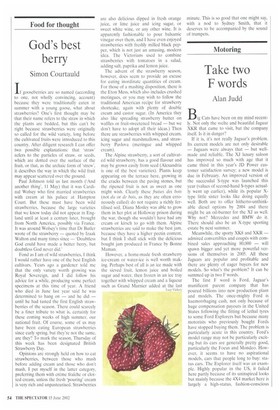Take two F words
Alan Judd
Big Cats have been on my mind recently. Not only the svelte and beautiful Jaguar XKR that came to visit, but the company itself. Is it in danger?
If it is, it's not really Jaguar's problem. Its current models are not only desirable — Jaguars were always that — but wellmade and reliable. The XJ luxury saloon has improved so much with age that it came third in this year's JD Power customer satisfaction survey; a new model is due in February. An improved version of the successful S-type was launched this year (values of second-hand S-types actually went up earlier), while its popular Xtype little sister looks like doing equally well. Both are to offer hitherto-unthinkable diesel options by 2004 and there might be an oil-burner for the XJ as well. Why not? Mercedes and BMW do it. There should also be an X-type sporting estate by next summer.
Meanwhile, the sporty XK8 and XKR — admired convertibles and coupe's with combined sales approaching 80.000 — will spawn bigger and yet more powerful versions of themselves in 2005. All these Jaguars are popular and profitable and there are plenty of eager buyers for new models. So what's the problem? It can be summed up in two F words.
The first F word is Ford, Jaguar's munificent parent company that has poured billions into new production plant and models. The once-mighty Ford is haemorrhaging cash, not only because of huge compensation payouts in the United States following the fitting of lethal tyres to some Ford Explorers but because many motorists who previously bought Fords have stopped buying them. The problem is particularly acute in this country. Ford's model range may not be particularly exciting but its cars are generally pretty good, particularly the Focus and Monde°. However, it seems to have no aspirational models, cars that people long to buy: status cars. The Explorer itself was an example. Highly popular in the US, it failed here partly because of its uninspired looks but mainly because the 4X4 market here is largely a high-status, fashion-conscious
market, and how many of those buyers look at Fords?
At the same time. Fords have become nearly as expensive as those that do have status, so customers go there. If contemplating, say, a Mondeo Ghia for £18,245, a BMW 316i for £18,635 or an X-type Jaguar for £19,995, which would you choose? The Mondeo might be better equipped, might in some ways be a better car, but most of us paying that sort of money want more than wheels; we want something we like to be seen in, and we want the feel of quality. And the values of Fords after three years are typically 30 per cent to 40 per cent of new price, the others around 50 per cent.
Ford's problems led to the departure of their previous boss, Jacques Nasser, then to the departure of the head of their Premier Automotive Group (the UK-based group that includes Jaguar, Land Rover and Aston Martin), Wolfgang Reitzle. Reitzle was keen to spend more on Jaguar, but now Ford want to spend less — which brings us to the second F word.
That is — perhaps was — the Jaguar Ftype, an exciting and aggressive sportscar intended to rival the Porsche Boxter. It seemed set to generate something of the excitement accorded its alphabetical predecessor, the E-type; but now it looks as if it has been shelved, or at best postponed. In short-term accounting terms this is probably a sensible decision, with all the figures pointing that way. But, in the longer term, it is surely a mistake.
People buy Jaguars partly because Jaguar once spawned such automotive icons as the E-type and its predecessors — and may do so again. When they buy their base-model X-type they are buying into that tradition, they want to be associated with that particular DNA inheritance. They don't want cars just to get them from A to B, they want magic as well. Ultimately, it is a question of imaginative appeal. That's why projects such as the F-type are so important; they keep the genes flowing and they make all types of Jaguar more popular. It's also why you can always sell a Jag, no matter how old and ropey. An exciting and successful F-type is Jaguar's seed-corn for the future; don't throw it away.
The other worrying feature of this decision is that it could mean that Ford is repeating one of the mistakes of the old British Leyland. Leyland owned brands that were potentially innovative and naturally popular — Jaguar, Rover, Land Rover, MG — plus a host of sub-Mondeo equivalents. Instead of putting money into improving the cars people most wanted, Leyland used it to sustain cars they no longer wanted — and there was never enough of it. anyway. The result we all know.
I had intended this to be about the XKR, the silver bird of passage that stayed, alas, for only a week, but it was too good a drive to sum up in a sentence or two. More next time.



































































 Previous page
Previous page